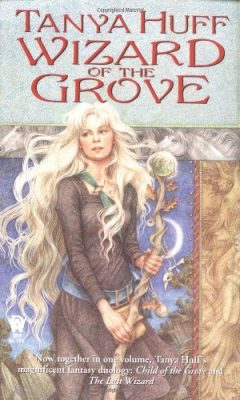Reviewer: Emera
Date read: 9.3.2016; 9.17.2016
Book from: Personal collection
Wizard of the Grove is an omnibus reedition of Tanya Huff’s 1988/1989 romantic high fantasy duology, Child of the Grove and The Last Wizard. I picked this up back in high school based on the lovely cover art (which I note has been redone recently to be trendily dark, teal, and high-contrast), subsequently reread it several times, and then lent it out repeatedly for a number of years. I only just recovered it, in fact, and celebrated with a rapid reread (the first in almost 10 years, I think).
Child of the Grove concerns the birth and ascendance of the world’s final wizard, a quasi-dryad named Crystal, who is conceived in order to combat the world’s cruel, corrupt, imperializing second-to-last wizard. The Last Wizard details Crystal’s adventures after she’s already saved the world – a narrative conceit that I enjoy.
The series is firmly middle-of-the-road high fantasy, complete with many glowing jewel-colored eyes, internal monologues about the fate of the world must rest on one’s young shoulders, and a villain remarkable only in how generic he is. (He does have chest hair in addition to his flowing red-gold locks, which is how you know this is from the ’80’s.)
However, Huff executes the usual conventions with a really likable combination of toughness and sweetness, her characters (minus aforementioned villain) are credible (if some of them are eye-rollingly juvenile, other characters actually call them out on it), and her plots are briskly paced and incorporate a fun variety of narrative elements.
Child of the Grove was always memorable to me in how it moves through several distinct narrative stages: first, a few rounds of mythical backstory, mixed with multigenerational soap opera. (Oh how I loved the soap opera in high school – I can’t take it so seriously anymore, but the characters are still pleasant to read about.) Then, a bracing outbreak of war; followed by a blend of training montage and magical war-waging; followed by, finally, a very brief Quest. (On rereading, it was puzzling to me that the climaxes of both Child and Wizard happen so damn fast; they felt a bit anticlimactic, Child especially. My view of Wizard was probably skewed by the fact that I still remembered the climax with almost word-for-word fidelity, so it was hard to actually perceive the action as written, if that makes sense.)
Other points of appeal:
- Huff has a knack for writing tough, acerbic female side characters who stand out as intriguing enough to be deserving of their own stories, even if they only appear for a page or two.
- There’s a good bit of funny dialogue.
- The love quadrangle in Wizard still held up for me as sweetly rendered and amusing, a pleasant mixture of innocence and experience. When I first read it, Crystal’s main relationship was definitely a landmark in representing several dimensions of romantic/sexual experience. First, a female protagonist who read as young enough for me to identify with her, but whose sexual experience was taken as a nondramatic given. Second, a female protagonist who deliberately chose the easygoing joker as her partner over the sensitive, wounded, and introspective option. (This is to be distinguished from female protagonists who make the duh choice of the Fun One over the Intense But Uptight One, e.g., Alana in Song of the Lioness.) This was startling and refreshing to me in high school, and I think still holds up as such, given that most fantasy is still basically romantic in its ideals, Grimdark incursion notwithstanding.
– E
